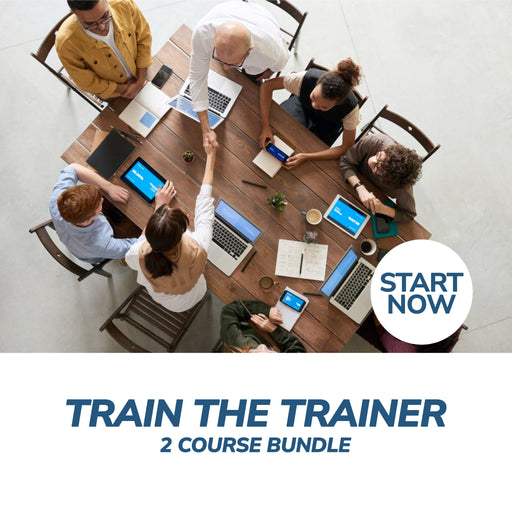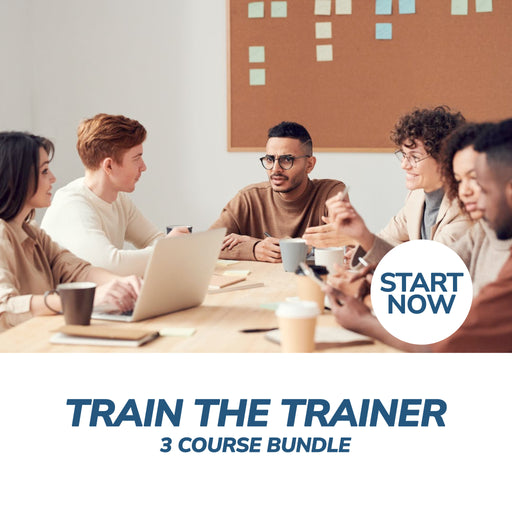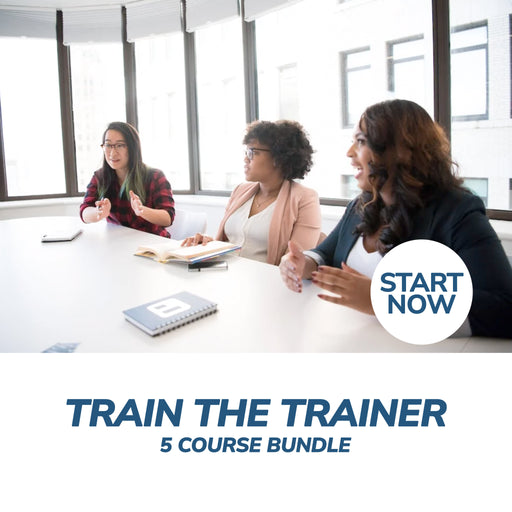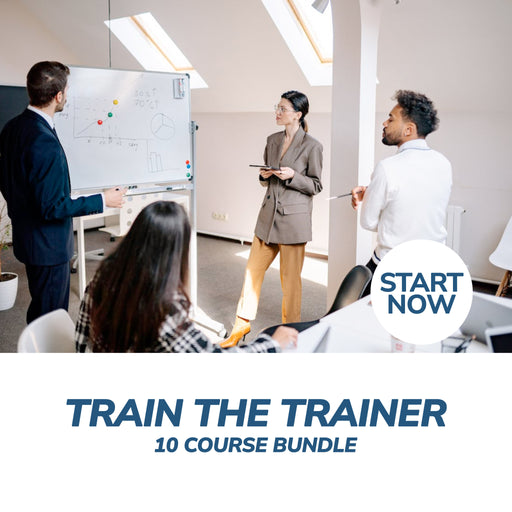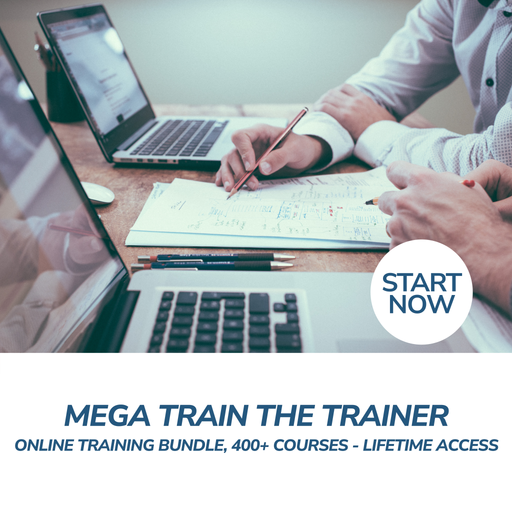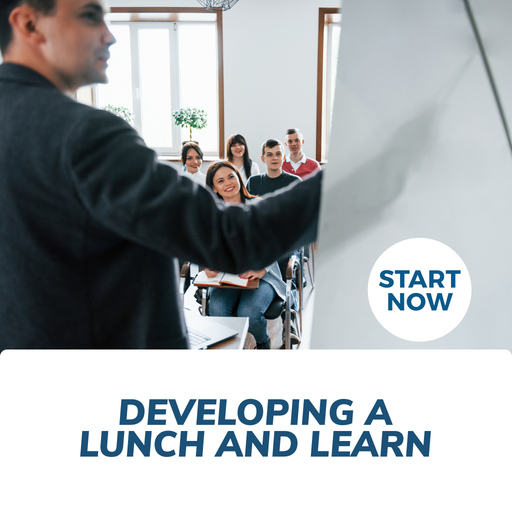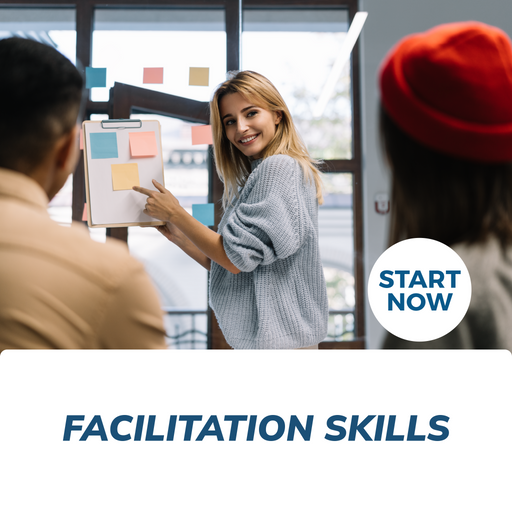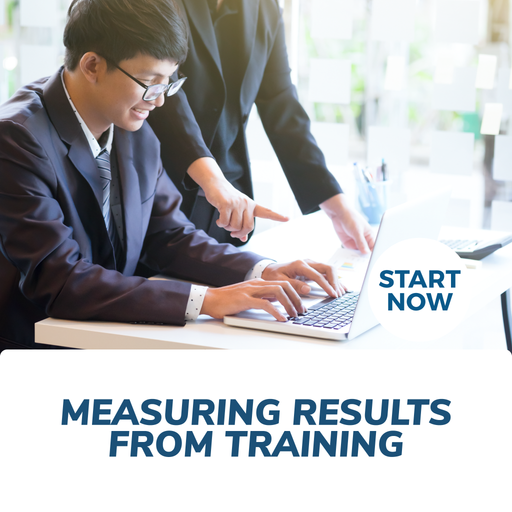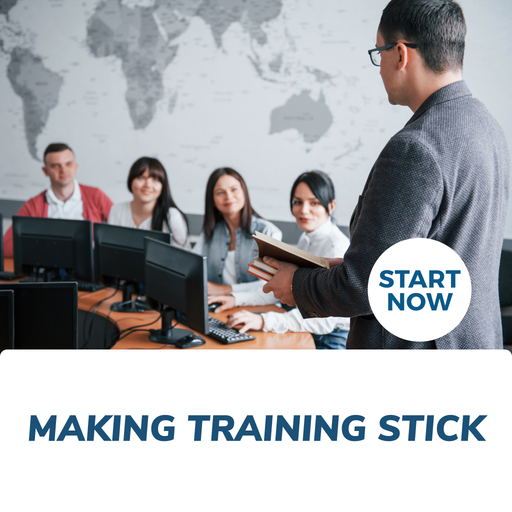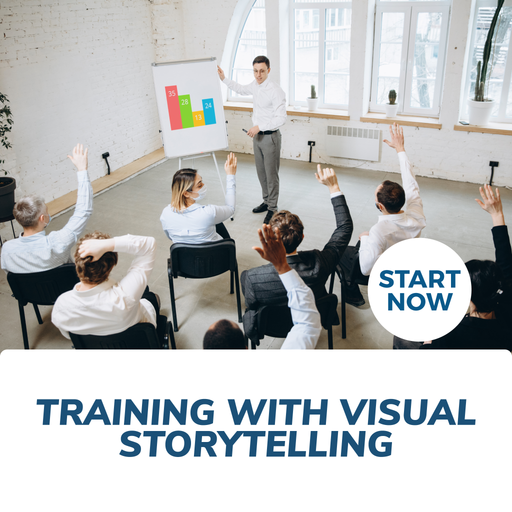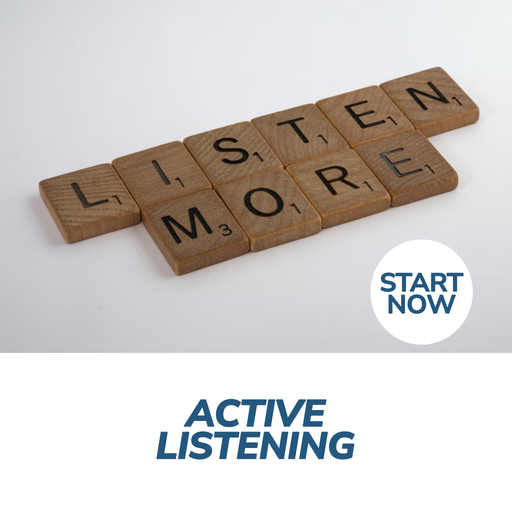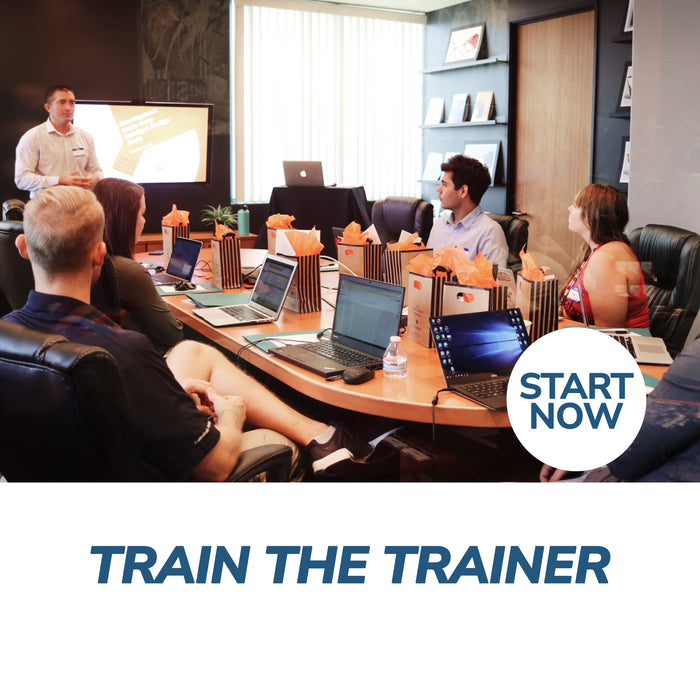
About This Course
Enjoy these Benefits and Take Advantage of our Comprehensive Train the Trainer Courses Today!
|
|
Study our Train the Trainer Online Course. Learn the skills and knowledge that is required to become a proficient trainer
This train-the-trainer online course from Courses for Success will prepare you to deliver engaging and informative training sessions. It helps to certify trainers by giving them effective skills training, and this provides them with all the knowledge they need to be a full-time or part-time trainer.
It teaches both aspiring and experienced trainers alike essential leadership and management skills and offers insights into how to tailor the adult learning experience to all different types of learners. Ultimately, this course will give learners new critical skill sets and competencies that they can use to become a confident and effective trainer.
Before you receive your trainer certificate, the skills you have to learn will include facilitation, needs analysis, and management of tough topics. Honing these critical skills will give you the confidence to become the best trainer you can be.
What are the skill requirements for the certificate?
The train the trainer certification program has been designed for people that have little-to-no prior experience in the training sector and who would like to begin a career as a professional trainer.
However, those who already have experience, whether through onsite training or a single train-the-trainer workshop, could stand to gain valuable new insights.
The training and development course is delivered 100% online and it only takes six to eight hours of study time to complete. The materials are also available to learners 24/7 with the option to download course materials for future reference.
In order to qualify for our training certificate, learners will be required to:
Have access to the internet and possess the necessary technical skills to navigate the training online through our learning resources.
Have access to any mobile device with internet connectivity, such as a laptop, desktop, or tablet.
Be a self-directed learner.
Able to follow step-by-step processes
Possess sound language and literacy skills.
Quick course facts:
Here are a few things students need to know about our train the trainer online certification program:
Course content is structured for easy comprehension.
They take approximately eight hours of study to complete.
Once registered you will be able to instantly access the course.
Registered students gain unrestricted lifetime access to our Train The Trainer online course.
All course material is available online 24/7 and can be accessed using any device.
You can study the trainer online course from anywhere in your own time and at your own pace.
All students who complete the course will be awarded a certificate of completion that is applicable worldwide.
For any additional questions, please refer to our comprehensive FAQs tab above to find out more information about the course.
Train the Trainer Online Course Outline
The training participant can expect their virtual classroom training to be a blended learning experience, touching on a wide variety of development skills and taught through different experiential learning techniques.
The virtual classroom setting aims to make you more than just a certified trainer. At Courses for Success, we want you to be well-equipped and confident to work in any training environment that you choose to enter into, whether that’s business training, Canfield training, delivering training to health and safety professionals, or another field of leadership development.
Below is a step-by-step process of what you can expect when you sign up for our train the trainer programs.
Module 1: Getting started
The introduction to training course starts with an overview of the essential skills you’ll learn. By affording ample opportunity for skills practice, instructor development, and management and leadership, the course overall helps to prepare you for work as a professional trainer or someone who is required to perform training as part of their job. It gives you the background to become a master trainer; a training specialist when it comes to training professionals in any industry.
This training course gives you all the practical trainer tools you need to deliver engaging and compelling training skills to trainees.
The course objectives:
Define training, facilitating, and presenting.
Understand how to identify participants' training needs.
Create a lesson plan that can accommodate a range of learning styles.
Create an active, engaging learning environment.
Develop visual aids and supporting materials.
Manage difficult participants and tough topics.
Module 2: Understanding training and facilitation
The second module of the train-the-trainer course focuses on training and facilitator techniques and how they help trainees make the most of the learning process.
What is training?
Training is a multifaceted discipline that deploys various methods to bring about behavioral change. It is a process that starts when a participant signs up for a class or program and ends when the student can naturally display the skills, knowledge, or attitude they were taught.
What is the training process?
Identifying the need for new learning.
Securing management buy-in for training to be developed.
Creating participant-centered learning opportunities.
Evaluating the effectiveness of the training offered.
What is facilitation?
The role of a trainer and facilitator are often used interchangeably, but these job descriptions do have fundamental differences. To put it plainly, a trainer is a subject matter expert who is qualified to teach or train students in their area of expertise. Facilitators, on the other hand, are responsible for providing direction, facilitating training, or creating an environment that is conducive to training.
What are the basic skills of a facilitator?
Ensuring everyone participates in a training session.
Ensuring that everyone is focused and understands the problems or needs that are being addressed.
Maintaining a safe and conducive learning environment for trainers and students alike.
Module 3: Gathering materials
On this module of the online Train The Trainer course, students will learn how to anticipate the needs, expectations, and learning styles of trainees to offer effective learning. In this part of the course, you will learn how to discuss, identify, and address these needs.
Identifying participants’ needs
It’s important to know your participants while also considering management or supervisor expectations.
Learn to conduct a needs assessment to determine if all concerns (both participants’ and supervisors’) need to be addressed.
Learn all trainees’ current skills levels and gauge their level of knowledge and previous work experience.
Reviewing materials
Design course training materials so that they are current and relevant.
Be careful with the information you use, especially anything sourced from the internet. All information used during a training session should be verified or come from a trusted source.
Ensure that all training materials are original or, if not, that you have the written permission from the copyright holder to use them.
Module 4: Choosing activities
As a trainer, you need to encourage critical thinking through your training design. For most people, hands-on training or actual application of concepts is the best way to learn, even in virtual training environments.
This module will teach you to develop training activities that support key learning objectives, keep students engaged, and make it easier for trainers to verify student learning outcomes.
What are the benefits of planned activities?
Gives you a chance to improve your practice delivery before a training session.
Keeps training fast-paced and stimulating.
Helps bring people together and removes barriers.
Lightens the mood and reduces stress levels.
Improves learning retention through hands-on application and practice.
What are some examples of learning activities?
Choosing the right activity requires subject matter expertise. A good trainer must know what activities will work best for each training concept.
In addition, trainers must also be able to provide a variety of activities to keep participants engaged. These might include and are not limited to the following:
Games.
Icebreakers.
Energizers.
Simulations.
Role plays.
Case studies.
Preparing for emergencies.
Module 5: Preparing for the course
Organization and preparedness are must-have qualities of a competent trainer, whether they work in health and safety training, corporate training, or something in between. Not having adequate training solutions to hand or a plan for your overall training project can get you derailed before training even starts.
Setting up the classroom
To create a conducive training environment, a trainer must first ensure that the physical location meets the following requirements:
It must be free from obstructions (including pillars) to avoid blind spots and it must have a minimum 10-foot-high ceiling.
The training room must have a rear entrance to ensure minimal distraction.
Tables and chairs must be equally spread throughout the room to avoid crowding.
For training sessions with five to 10 participants, use round tables to encourage discussion and give all participants equal access to the trainer.
All visual aids must be appropriate for the size of the room and the number of participants. You could use, for example, flip charts for groups of less than 20 people and projectors or large electronic whiteboards for training sessions with 20 or more participants.
Trainers must be experienced in the training equipment and software they choose to use.
Module 6: Getting off on the right foot
Customized training is a key skill that you will learn in our course. This skill will teach you to
get off on the right foot every single time and will help you to learn how to set the right mood for the whole session.
Greeting participants tips
Greet participants as they come in the door.
Request that participants use a name card or tent card so you can address them by name.
Ask participants to introduce themselves individually or, if working in large groups, ask a representative to introduce the group as a whole.
Use an icebreaker to kickstart the trainer workshop.
Introduce yourself as the trainer.
Create an open, welcoming training atmosphere.
Dress appropriately, whether that be formal attire for training in educational institutions or a conference center, or the right safety gear for a training activity you’re about to demonstrate.
Ask participants about their expectations and learning objectives.
Module 7: Delivery tips and tricks
You will learn about the different types of training delivery methods and when it’s appropriate to use them. For example, a microlearning design might not work so well in a corporate training series, although it could be well-suited to a standalone session on public speaking.
So, this module will offer you an insight into the training approaches you can employ in various settings. They will help you offer your trainees the best learning experiences possible.
1. Visual aids
Our brains construct pictures in our minds when people speak to us. So, we use visual aids to reinforce the concepts learned in training. There are a variety of visual aids that can be incorporated into training sessions, including PowerPoints, flip charts, and whiteboards, all of which help to facilitate better comprehension among trainees.
2. Video
Videos are also very useful visual aids. When planning to use video, here are some key considerations you should keep in mind:
Videos are perfect for demonstrating actions such as showing how to operate the equipment.
You need to ensure that all videos are original or that you have appropriate copyright permission.
Mark video sequences to ensure easy access and playback.
Always check to see if using video instead of a training manual might encourage faster learning.
Check that the video content you’ve chosen is adequate and ask yourself whether it might require the use of additional training materials such as manuals and lectures for support.
Videos should not be presented simply as a way of changing the pace of a training session but should instead be considered crucial to the design and delivery of the training process as a whole.
3. Whiteboards
Whiteboards have taken over old-school chalkboards. They have the same functionality as chalkboards but they come with additional advantages.
The information can, for example, be more easily transferred from one place to another using a whiteboard, and they’re cheap and easy to use, too. So, consider opting for whiteboards when your training session requires a lot of quick information or impromptu edits.
4. Flip charts
This visual aid is ideal for small groups. Flip charts offer you an easy training tool that requires minimal prep time. Below are a few tips on how to make flip charts more effective:
Prepare some sheets in advance.
Use highly saturated colors (eg. black, blue and red).
Leave room at the bottom of the page for edits.
Use highlights and markers to emphasize important points.
Stand to the side of the flip chart and face the participants when speaking.
Use a stick or point with your fingers to direct participants to the exact part of the chart you are currently discussing.
5. PowerPoint
This is the most popular slide-based presentation program used in business presentations, lectures, and other forms of training. It is important to remember that PowerPoints are used to highlight or emphasize important concepts and should contain as little text as possible.
Tips for supporting materials
Check that your training materials are appropriate for the size of the training room and the number of participants in a session.
Ensure that all information is visible to participants.
Make sure the visual aid you use is appropriate to the type of training.
Keep your materials simple and focus on the learning objectives, rather than focusing all your attention on the presentation.
Module 8: Keeping it interactive
If your participants are actively engaged and take responsibility for their training, that’s an indication that your training program has been well designed. In this part of the course, you will get to take a closer look at how to make training sessions more interactive and keep trainees focused.
How to keep participants engaged?
Give the participants direction by explaining the learning objectives from the outset.
Ensure maximum interaction between all participants by grouping them differently throughout the session.
Direct questions to the group.
Give participants enough time to process answers or formulate their own questions.
Encourage participation by respecting everyone’s answers and thanking them for their input.
Using group work
Provide clear direction when deploying group work in your training sessions, for example by offering topics for discussion or handing out case studies.
Ensure that all required training materials are provided and all groups have everything they need.
Move about the groups to check on their progress and offer help when needed.
Module 9: Dealing with difficult participants
Trainers do not have the luxury of choosing their students. As a trainer, part of the experience is interacting with students from all walks of life. While this is very often an enriching part of the job for corporate trainers and others, it also means they will inevitably come up against course participants who make things more difficult.
A difficult participant should not derail a successful trainer from the task at hand or influence the quality of training provided. In this module of the train-the-trainer course, we discuss how trainers can deal with difficult participants and maintain good classroom management practices.
Setting ground rules
Set the appropriate tone for the learning environment by laying down ground rules. Once everyone agrees with the rules, any disciplinary actions from rule infringement can be met more objectively. Things to keep in mind when setting ground rules are:
They should encourage respect.
They should leave space for participation and fun.
Everything that happens in a training session should be kept within the confines of that session. To ensure that happens, maintain a professional demeanor and do what you can to prevent experiences in training from becoming a source of gossip.
How to identify difficult participants’ traits?
It is important to be aware that whenever you will be hosting a training workshop, you will be expected to face a wide range of different participants and be able to develop strategies to manage the following personality types.
1. The joker
This type of person might feel that they are positively contributing to the training session by keeping the atmosphere light.
However, being funny requires proper timing, which can all too often go out the window when difficult concepts are being discussed. The solution is to talk with the participant and tell them that their training time is limited.
2. The cynic
This sort of person tends to feel unappreciated for their ideas and has seen their share of failures. Give them time to voice their objections and always make sure you acknowledge their opinion so they feel valued.
3. The indifferent
These are people who do not offer any opinions, whether positive or negative, on the training being provided.
They are content with going through the motions and would rather be left alone. To handle this situation, try to identify the cause or mix up the session’s activities until you get their attention.
4. The talker
Like the joker, this type of personality craves attention. Listen to their opinions but always ensure you give others the chance to talk, too. Then, approach them during the break and state that the training follows a strict time structure.
5. The whisperer
These people try to disrupt training by starting side discussions with other participants. When you notice them starting a discussion, call their attention politely and ask if there is something they want to share.
Be consistent in letting them know that you are aware of what they are doing without being aggressive.
Module 10: Tackling tough topics
Even train-the-trainer professionals with years of experience might find some sessions tough to design and deliver because of the nature of the topic being tackled. But, as professionals working with adult learners, we must constantly keep in mind that dealing with difficult subject matter is all part of effective program management.
The final training module in this Train The Trainer course covers how to handle difficult topics and how you can use the right delivery skills. This concluding virtual classroom training session will teach you top tips for facing uncomfortable topics and navigating your participants through them.
Further Learning
Here at Courses for Success, we want you to make the most of your learning and development. As such we offer a range of course types and course categories that can assist with adult learning principles in a range of fields.
From business writing to communication training, workplace safety for safety professionals to teaching training and technical training. There’s a CFS course for every industry.
Recognition and accreditation
Upon successful completion of this live online course and achieving a passing score for the assessment, you will become a qualified Trainer. You will also be issued with an international continuing education credit (CEU) certificate.
The Certificate is applicable worldwide, which demonstrates your commitment to learning new skills. You can share the certificate with your friends, relatives, co-workers, and potential employers. Also, include it in your resume/CV, professional social media profiles and job applications.
Units of Study
Module One: Getting Started
Module Two: Understanding Training and Facilitation
• What is Training?
• What is Facilitation?
• Identifying Appropriate Situations for Each
Module Three: Gathering Materials
• Identifying Participants' Needs
• Reviewing the Materials
• Identifying and Resolving Gaps
Module Four: Creating a Lesson Plan
• Planning for the Basics
• Adding Slack Time
• Creating a Plan B
• A Take-Home Template
Module Five: Choosing Activities
• Types of Activities
• Creating a Tickle Trunk
• What To Do When Games Go Wrong
Module Six: Preparing for the Workshop
• Creating a Materials List
• Gathering Participant Information
• Setting up the Physical Location
Module Seven: Getting off on the Right Foot
• Greeting Participants
• Being Prepared
• Using Icebreakers
Module Eight: Delivery Tips and Tricks
• Using Visual Aids
• Creating Supporting Materials
• Gauging When It's Time For A Break
Module Nine: Keeping it Interactive
• Encouraging Discussion
• Using Group Work
• The Power of Post-It Notes
Module Ten: Dealing with Difficult Participants
• The Ground Rules
• Challenges and Solutions
• Handling Interruptions
Module Eleven: Tackling Tough Topics
• Tough Stuff to Watch Out For
• Adjusting Your Material for a Sensitive Issue
• Dealing with Sensitive Issues in the Workshop
Module Twelve: Wrapping Up
Requirements
Entry requirements
Students must have basic literacy and numeracy skills.
Minimum education
Open entry. Previous schooling and academic achievements are not required for entry into this course.
Device requirements
Students will need access to a computer/any device and the internet.
Requirements
Entry requirements:
Students must have basic literacy and numeracy skills.
Minimum education:
Open entry. Previous schooling and academic achievements are not required for entry into this course.
Device requirements:
Students will need access to a computer/any device and the internet.
FAQS
1. Who are Courses For Success?
Courses For Success is a course platform that started in 2008
with 5 courses, since then we have grown to over 10,000 online courses.
Our courses span across the following categories:
•Animal
•Beauty
•Business
•Health & Fitness
•Finance
•Lifestyle
•IT & Software
•Personal Development
•Teaching & Academics
2. Is there a refund/cancellation policy?
Yes, we have a 7-day money-back refund guarantee. Just send us an email to info@coursesforsuccess.com with the subject Courses For Success Refund so we can accommodate your request.
3. What is the FREE Personal Success Training Program?
The Personal Success Training Program
was developed by Courses For Success to help our customers achieve
success. Currently, we are offering this program for FREE with every
course or bundle purchase this month. This is a limited time offer!
4. Are there any requirements to study this course?
No,
anyone who has an interest in learning more about this subject matter
is encouraged to take our course. There are no entry requirements to
take this course.
5. Do I require to have finished high school to complete this course?
No,
you do not require a High School Diploma or to have finished school to
study this course, this course is open to anyone who would like to take
this course.
6. What if English is not my first language?
This
course is provided in English, however, due to the digital nature of
our training, you can take your time studying the material and make use
of tools such as google translate and Grammarly.
7. Is this course online or conducted in person?
All our courses are accessible online on any device. You may complete them at your own pace and at your own time.
8. How do I receive my course?
After
you have completed the payment, you will receive a confirmation email
and tax receipt. You will also receive an email containing your course
login details (username and password), as well as instructions on how to
access and log in to your course via the internet with any device,
please check your junk/spam folder in the event that you do not receive
the email.
9. When does this course start?
Providing
you have internet access you can start this course whenever you like,
just go to the login page and insert your username and password and you
can access the online material.
10. What is online learning like?
Online learning is easy, if not easier than a traditional academic situation.
By studying an online course, the usual boundaries caused by location and time constraints are eliminated, meaning you are free to study where and when you want at your own pace.
Of course, you will need to be able to self-manage your time and be organized, but with our help, you’ll soon find yourself settling into a comfortable rhythm of study.
11. What computer skills do I need for my course?
You
don't need to be a computer expert to succeed with our online training,
but you should be comfortable typing, using the internet and be capable
of using common software (such as Microsoft word).
12. How long will you have access to the online course?
The majority of our courses have unlimited lifetime access, meaning you can access this course whenever you want.
Please also check the course summary, as a small selection of courses have limited access.
13. How long will my course take?
Course duration, is listed under Course Summary
14. Do I need to buy textbooks?
All the required material for your course is included in the online system, you do not need to buy anything else.
15. Is the course interactive?
Yes, all our courses are interactive.
16. Is there an assessment or exam?
Yes,
you will be required to complete a multiple-choice test online at the
end of your course, you can do this test as many times as you require.
17. What type of certificate will I receive?
You
will receive a Certificate of Completion that is applicable worldwide,
which demonstrates your commitment to learning new skills. You can share
the certificate with your friends, relatives, co-workers and employers.
Also, include it in your resume/CV, professional social media profiles
and job applications.
Wendy Sue Hunt - 5 STAR REVIEW
"If you are considering taking any “Courses for Success”, I would highly recommend it. I have always been a firm believer it’s important to always sharpen your skills. You are never too old to learn more. I found the courses very helpful, interesting and easy to understand.
The term “Courses for Success” helped me in my current position to succeed. After completing the courses, I gave my manager the completion certificates. Recently I received a promotion too."
Valencia Marie Aviles - 5 STAR REVIEW
"I
had a very good experience with my course. It has helped me to get
multiple jobs and prepared me for almost everything I would need to
know. The course was very informative and easy to understand and broken
up perfectly to be done in a short amount of time while still learning a
good amount! I would recommend Courses for Success to anyone trying to
get abs certifications for job advancements, it is well worth it!"
ELENA GRIFFIN - 5 STAR REVIEW
"I have absolutely enjoyed the materials from Courses for Success. The materials are easy to understand which makes learning enjoyable. Courses for Success have great topics of interest which make you come back for
more.
Thank you Courses for Success for being part of my learning journey and making education affordable!"
Our
completion certificates are very valuable and will help you progress in
your work environment and show employers how committed you are to learn
new skills, you might even get a promotion.
18. Will this course be credited by universities?
No, it is not equivalent to a college or university credit.
19. Am I guaranteed to get a job with this certificate?
This course will give you the skills you need to help you obtain employment, but it’s up to you if you get the job or not.
20. How will this course assist me with my career?
Studying
and completing this course will show employers that you have the
knowledge in this field, additionally you will gain more confidence in
this area of expertise.
21. How long is the certificate valid for?
The Certificates are valid for life and do not need renewing.
22. Can I take more than one course at a time?
Courses
are studied online at your own pace and you are free to study as many
or as few courses as you wish, we also offer online course bundles that
allow you to save on additional courses so that you may get all the
topics related to your training goals in one go.
23. What are the Payment Methods available? Is there a payment plan?
We accept payments via PayPal, Credit Card and Bank Transfer.
Payment Plans: We have partnered with Partial.ly, to offer our own in house payment plan. Everyone is Pre-Approved, providing the initial deposit is paid in full.
To pay via bank transfer contact us info@coursesforsuccess.com
24. Can I purchase for multiple people?
Yes, you can do this by purchasing individually via website or send us a request via email at info@coursesforsuccess.com
25. Can I request for an invoice before purchase?
Yes, you can request for an invoice via email at info@coursesforsuccess.com
26. Purchase for a gift?
Yes, you can purchase this course as a gift, simply send an email to info@coursesforsuccess.com, with the course details and we can accommodate this.
27. Can I create my own course bundle?
Yes,
you can customize your own bundle. Please send us the complete list
with the exact course link of the courses you'd like to bundle up via
email info@coursesforsuccess.com and we will create them for you. *Each course access, time of completion and certification varies depending on the course type.
28. How will I contact Courses For Success if I have any questions?
You can contact our support team, at any time through live chat on our website, or email at info@coursesforsuccess.com, or by calling one of our phone numbers depending on which country you are in.
Free Personal Success Training Course
The Personal Success Training Program Helps You Stay Focused To Achieve Your Goals!
This month, we are providing it for Free with all Course Purchases, as a special offer!
Benefits:
• How to layout a Success Plan.
• Get where you want to be in life.
• How to unclutter your mind to succeed.
• Achieve your dreams using your imagination.
• How to have faith in yourself.
Features:
• Life time access
• Complement your individual course purchase.
• Click here Personal Success Training Program to see thousands of positive reviews,
Hurry - offer - ends this month!
Course Bundles
Looking for specific training for yourself or employees. Choose from our Course Bundles below or build you own Bundle, by adding more courses to your cart. Choose different courses or the same course for multiple staff members and receive volume discounts at checkout.
Train The Trainer Online Certificate Course
"I found this course insightful and interesting. It's highlighted key pieces of information for me to learn and enable to do my job better." - Kirsty C. Verified Buyer.
Train smarter, not harder, with our Train The Trainer Online Certificate Course. Get the skills you need to deliver engaging and informative training sessions with confidence. Our course offers an interactive experience and comprehensive training tailored to your needs. Transform yourself into a master trainer today!
Bundle Up & Save - Learn More and Save More when you Upgrade to one of our Course Bundles below - Save Up To 98%
Course Summary
- Delivery: Online
- Access: Unlimited Lifetime
- Time: Study at your own pace
- Duration: 6 Hours
- Assessments: Yes
- Qualification: Certificate
3 DAY SALE - ENDS 25 ARPIL
GET IN NOW & SAVE!
About This Course
Enjoy these Benefits and Take Advantage of our Comprehensive Train the Trainer Courses Today!
|
|
Study our Train the Trainer Online Course. Learn the skills and knowledge that is required to become a proficient trainer
This train-the-trainer online course from Courses for Success will prepare you to deliver engaging and informative training sessions. It helps to certify trainers by giving them effective skills training, and this provides them with all the knowledge they need to be a full-time or part-time trainer.
It teaches both aspiring and experienced trainers alike essential leadership and management skills and offers insights into how to tailor the adult learning experience to all different types of learners. Ultimately, this course will give learners new critical skill sets and competencies that they can use to become a confident and effective trainer.
Before you receive your trainer certificate, the skills you have to learn will include facilitation, needs analysis, and management of tough topics. Honing these critical skills will give you the confidence to become the best trainer you can be.
What are the skill requirements for the certificate?
The train the trainer certification program has been designed for people that have little-to-no prior experience in the training sector and who would like to begin a career as a professional trainer.
However, those who already have experience, whether through onsite training or a single train-the-trainer workshop, could stand to gain valuable new insights.
The training and development course is delivered 100% online and it only takes six to eight hours of study time to complete. The materials are also available to learners 24/7 with the option to download course materials for future reference.
In order to qualify for our training certificate, learners will be required to:
Have access to the internet and possess the necessary technical skills to navigate the training online through our learning resources.
Have access to any mobile device with internet connectivity, such as a laptop, desktop, or tablet.
Be a self-directed learner.
Able to follow step-by-step processes
Possess sound language and literacy skills.
Quick course facts:
Here are a few things students need to know about our train the trainer online certification program:
Course content is structured for easy comprehension.
They take approximately eight hours of study to complete.
Once registered you will be able to instantly access the course.
Registered students gain unrestricted lifetime access to our Train The Trainer online course.
All course material is available online 24/7 and can be accessed using any device.
You can study the trainer online course from anywhere in your own time and at your own pace.
All students who complete the course will be awarded a certificate of completion that is applicable worldwide.
For any additional questions, please refer to our comprehensive FAQs tab above to find out more information about the course.
Train the Trainer Online Course Outline
The training participant can expect their virtual classroom training to be a blended learning experience, touching on a wide variety of development skills and taught through different experiential learning techniques.
The virtual classroom setting aims to make you more than just a certified trainer. At Courses for Success, we want you to be well-equipped and confident to work in any training environment that you choose to enter into, whether that’s business training, Canfield training, delivering training to health and safety professionals, or another field of leadership development.
Below is a step-by-step process of what you can expect when you sign up for our train the trainer programs.
Module 1: Getting started
The introduction to training course starts with an overview of the essential skills you’ll learn. By affording ample opportunity for skills practice, instructor development, and management and leadership, the course overall helps to prepare you for work as a professional trainer or someone who is required to perform training as part of their job. It gives you the background to become a master trainer; a training specialist when it comes to training professionals in any industry.
This training course gives you all the practical trainer tools you need to deliver engaging and compelling training skills to trainees.
The course objectives:
Define training, facilitating, and presenting.
Understand how to identify participants' training needs.
Create a lesson plan that can accommodate a range of learning styles.
Create an active, engaging learning environment.
Develop visual aids and supporting materials.
Manage difficult participants and tough topics.
Module 2: Understanding training and facilitation
The second module of the train-the-trainer course focuses on training and facilitator techniques and how they help trainees make the most of the learning process.
What is training?
Training is a multifaceted discipline that deploys various methods to bring about behavioral change. It is a process that starts when a participant signs up for a class or program and ends when the student can naturally display the skills, knowledge, or attitude they were taught.
What is the training process?
Identifying the need for new learning.
Securing management buy-in for training to be developed.
Creating participant-centered learning opportunities.
Evaluating the effectiveness of the training offered.
What is facilitation?
The role of a trainer and facilitator are often used interchangeably, but these job descriptions do have fundamental differences. To put it plainly, a trainer is a subject matter expert who is qualified to teach or train students in their area of expertise. Facilitators, on the other hand, are responsible for providing direction, facilitating training, or creating an environment that is conducive to training.
What are the basic skills of a facilitator?
Ensuring everyone participates in a training session.
Ensuring that everyone is focused and understands the problems or needs that are being addressed.
Maintaining a safe and conducive learning environment for trainers and students alike.
Module 3: Gathering materials
On this module of the online Train The Trainer course, students will learn how to anticipate the needs, expectations, and learning styles of trainees to offer effective learning. In this part of the course, you will learn how to discuss, identify, and address these needs.
Identifying participants’ needs
It’s important to know your participants while also considering management or supervisor expectations.
Learn to conduct a needs assessment to determine if all concerns (both participants’ and supervisors’) need to be addressed.
Learn all trainees’ current skills levels and gauge their level of knowledge and previous work experience.
Reviewing materials
Design course training materials so that they are current and relevant.
Be careful with the information you use, especially anything sourced from the internet. All information used during a training session should be verified or come from a trusted source.
Ensure that all training materials are original or, if not, that you have the written permission from the copyright holder to use them.
Module 4: Choosing activities
As a trainer, you need to encourage critical thinking through your training design. For most people, hands-on training or actual application of concepts is the best way to learn, even in virtual training environments.
This module will teach you to develop training activities that support key learning objectives, keep students engaged, and make it easier for trainers to verify student learning outcomes.
What are the benefits of planned activities?
Gives you a chance to improve your practice delivery before a training session.
Keeps training fast-paced and stimulating.
Helps bring people together and removes barriers.
Lightens the mood and reduces stress levels.
Improves learning retention through hands-on application and practice.
What are some examples of learning activities?
Choosing the right activity requires subject matter expertise. A good trainer must know what activities will work best for each training concept.
In addition, trainers must also be able to provide a variety of activities to keep participants engaged. These might include and are not limited to the following:
Games.
Icebreakers.
Energizers.
Simulations.
Role plays.
Case studies.
Preparing for emergencies.
Module 5: Preparing for the course
Organization and preparedness are must-have qualities of a competent trainer, whether they work in health and safety training, corporate training, or something in between. Not having adequate training solutions to hand or a plan for your overall training project can get you derailed before training even starts.
Setting up the classroom
To create a conducive training environment, a trainer must first ensure that the physical location meets the following requirements:
It must be free from obstructions (including pillars) to avoid blind spots and it must have a minimum 10-foot-high ceiling.
The training room must have a rear entrance to ensure minimal distraction.
Tables and chairs must be equally spread throughout the room to avoid crowding.
For training sessions with five to 10 participants, use round tables to encourage discussion and give all participants equal access to the trainer.
All visual aids must be appropriate for the size of the room and the number of participants. You could use, for example, flip charts for groups of less than 20 people and projectors or large electronic whiteboards for training sessions with 20 or more participants.
Trainers must be experienced in the training equipment and software they choose to use.
Module 6: Getting off on the right foot
Customized training is a key skill that you will learn in our course. This skill will teach you to
get off on the right foot every single time and will help you to learn how to set the right mood for the whole session.
Greeting participants tips
Greet participants as they come in the door.
Request that participants use a name card or tent card so you can address them by name.
Ask participants to introduce themselves individually or, if working in large groups, ask a representative to introduce the group as a whole.
Use an icebreaker to kickstart the trainer workshop.
Introduce yourself as the trainer.
Create an open, welcoming training atmosphere.
Dress appropriately, whether that be formal attire for training in educational institutions or a conference center, or the right safety gear for a training activity you’re about to demonstrate.
Ask participants about their expectations and learning objectives.
Module 7: Delivery tips and tricks
You will learn about the different types of training delivery methods and when it’s appropriate to use them. For example, a microlearning design might not work so well in a corporate training series, although it could be well-suited to a standalone session on public speaking.
So, this module will offer you an insight into the training approaches you can employ in various settings. They will help you offer your trainees the best learning experiences possible.
1. Visual aids
Our brains construct pictures in our minds when people speak to us. So, we use visual aids to reinforce the concepts learned in training. There are a variety of visual aids that can be incorporated into training sessions, including PowerPoints, flip charts, and whiteboards, all of which help to facilitate better comprehension among trainees.
2. Video
Videos are also very useful visual aids. When planning to use video, here are some key considerations you should keep in mind:
Videos are perfect for demonstrating actions such as showing how to operate the equipment.
You need to ensure that all videos are original or that you have appropriate copyright permission.
Mark video sequences to ensure easy access and playback.
Always check to see if using video instead of a training manual might encourage faster learning.
Check that the video content you’ve chosen is adequate and ask yourself whether it might require the use of additional training materials such as manuals and lectures for support.
Videos should not be presented simply as a way of changing the pace of a training session but should instead be considered crucial to the design and delivery of the training process as a whole.
3. Whiteboards
Whiteboards have taken over old-school chalkboards. They have the same functionality as chalkboards but they come with additional advantages.
The information can, for example, be more easily transferred from one place to another using a whiteboard, and they’re cheap and easy to use, too. So, consider opting for whiteboards when your training session requires a lot of quick information or impromptu edits.
4. Flip charts
This visual aid is ideal for small groups. Flip charts offer you an easy training tool that requires minimal prep time. Below are a few tips on how to make flip charts more effective:
Prepare some sheets in advance.
Use highly saturated colors (eg. black, blue and red).
Leave room at the bottom of the page for edits.
Use highlights and markers to emphasize important points.
Stand to the side of the flip chart and face the participants when speaking.
Use a stick or point with your fingers to direct participants to the exact part of the chart you are currently discussing.
5. PowerPoint
This is the most popular slide-based presentation program used in business presentations, lectures, and other forms of training. It is important to remember that PowerPoints are used to highlight or emphasize important concepts and should contain as little text as possible.
Tips for supporting materials
Check that your training materials are appropriate for the size of the training room and the number of participants in a session.
Ensure that all information is visible to participants.
Make sure the visual aid you use is appropriate to the type of training.
Keep your materials simple and focus on the learning objectives, rather than focusing all your attention on the presentation.
Module 8: Keeping it interactive
If your participants are actively engaged and take responsibility for their training, that’s an indication that your training program has been well designed. In this part of the course, you will get to take a closer look at how to make training sessions more interactive and keep trainees focused.
How to keep participants engaged?
Give the participants direction by explaining the learning objectives from the outset.
Ensure maximum interaction between all participants by grouping them differently throughout the session.
Direct questions to the group.
Give participants enough time to process answers or formulate their own questions.
Encourage participation by respecting everyone’s answers and thanking them for their input.
Using group work
Provide clear direction when deploying group work in your training sessions, for example by offering topics for discussion or handing out case studies.
Ensure that all required training materials are provided and all groups have everything they need.
Move about the groups to check on their progress and offer help when needed.
Module 9: Dealing with difficult participants
Trainers do not have the luxury of choosing their students. As a trainer, part of the experience is interacting with students from all walks of life. While this is very often an enriching part of the job for corporate trainers and others, it also means they will inevitably come up against course participants who make things more difficult.
A difficult participant should not derail a successful trainer from the task at hand or influence the quality of training provided. In this module of the train-the-trainer course, we discuss how trainers can deal with difficult participants and maintain good classroom management practices.
Setting ground rules
Set the appropriate tone for the learning environment by laying down ground rules. Once everyone agrees with the rules, any disciplinary actions from rule infringement can be met more objectively. Things to keep in mind when setting ground rules are:
They should encourage respect.
They should leave space for participation and fun.
Everything that happens in a training session should be kept within the confines of that session. To ensure that happens, maintain a professional demeanor and do what you can to prevent experiences in training from becoming a source of gossip.
How to identify difficult participants’ traits?
It is important to be aware that whenever you will be hosting a training workshop, you will be expected to face a wide range of different participants and be able to develop strategies to manage the following personality types.
1. The joker
This type of person might feel that they are positively contributing to the training session by keeping the atmosphere light.
However, being funny requires proper timing, which can all too often go out the window when difficult concepts are being discussed. The solution is to talk with the participant and tell them that their training time is limited.
2. The cynic
This sort of person tends to feel unappreciated for their ideas and has seen their share of failures. Give them time to voice their objections and always make sure you acknowledge their opinion so they feel valued.
3. The indifferent
These are people who do not offer any opinions, whether positive or negative, on the training being provided.
They are content with going through the motions and would rather be left alone. To handle this situation, try to identify the cause or mix up the session’s activities until you get their attention.
4. The talker
Like the joker, this type of personality craves attention. Listen to their opinions but always ensure you give others the chance to talk, too. Then, approach them during the break and state that the training follows a strict time structure.
5. The whisperer
These people try to disrupt training by starting side discussions with other participants. When you notice them starting a discussion, call their attention politely and ask if there is something they want to share.
Be consistent in letting them know that you are aware of what they are doing without being aggressive.
Module 10: Tackling tough topics
Even train-the-trainer professionals with years of experience might find some sessions tough to design and deliver because of the nature of the topic being tackled. But, as professionals working with adult learners, we must constantly keep in mind that dealing with difficult subject matter is all part of effective program management.
The final training module in this Train The Trainer course covers how to handle difficult topics and how you can use the right delivery skills. This concluding virtual classroom training session will teach you top tips for facing uncomfortable topics and navigating your participants through them.
Further Learning
Here at Courses for Success, we want you to make the most of your learning and development. As such we offer a range of course types and course categories that can assist with adult learning principles in a range of fields.
From business writing to communication training, workplace safety for safety professionals to teaching training and technical training. There’s a CFS course for every industry.
Recognition and accreditation
Upon successful completion of this live online course and achieving a passing score for the assessment, you will become a qualified Trainer. You will also be issued with an international continuing education credit (CEU) certificate.
The Certificate is applicable worldwide, which demonstrates your commitment to learning new skills. You can share the certificate with your friends, relatives, co-workers, and potential employers. Also, include it in your resume/CV, professional social media profiles and job applications.
Units of Study
Module One: Getting Started
Module Two: Understanding Training and Facilitation
• What is Training?
• What is Facilitation?
• Identifying Appropriate Situations for Each
Module Three: Gathering Materials
• Identifying Participants' Needs
• Reviewing the Materials
• Identifying and Resolving Gaps
Module Four: Creating a Lesson Plan
• Planning for the Basics
• Adding Slack Time
• Creating a Plan B
• A Take-Home Template
Module Five: Choosing Activities
• Types of Activities
• Creating a Tickle Trunk
• What To Do When Games Go Wrong
Module Six: Preparing for the Workshop
• Creating a Materials List
• Gathering Participant Information
• Setting up the Physical Location
Module Seven: Getting off on the Right Foot
• Greeting Participants
• Being Prepared
• Using Icebreakers
Module Eight: Delivery Tips and Tricks
• Using Visual Aids
• Creating Supporting Materials
• Gauging When It's Time For A Break
Module Nine: Keeping it Interactive
• Encouraging Discussion
• Using Group Work
• The Power of Post-It Notes
Module Ten: Dealing with Difficult Participants
• The Ground Rules
• Challenges and Solutions
• Handling Interruptions
Module Eleven: Tackling Tough Topics
• Tough Stuff to Watch Out For
• Adjusting Your Material for a Sensitive Issue
• Dealing with Sensitive Issues in the Workshop
Module Twelve: Wrapping Up
Requirements
Entry requirements
Students must have basic literacy and numeracy skills.
Minimum education
Open entry. Previous schooling and academic achievements are not required for entry into this course.
Device requirements
Students will need access to a computer/any device and the internet.
Requirements
Entry requirements:
Students must have basic literacy and numeracy skills.
Minimum education:
Open entry. Previous schooling and academic achievements are not required for entry into this course.
Device requirements:
Students will need access to a computer/any device and the internet.
FAQS
1. Who are Courses For Success?
Courses For Success is a course platform that started in 2008
with 5 courses, since then we have grown to over 10,000 online courses.
Our courses span across the following categories:
•Animal
•Beauty
•Business
•Health & Fitness
•Finance
•Lifestyle
•IT & Software
•Personal Development
•Teaching & Academics
2. Is there a refund/cancellation policy?
Yes, we have a 7-day money-back refund guarantee. Just send us an email to info@coursesforsuccess.com with the subject Courses For Success Refund so we can accommodate your request.
3. What is the FREE Personal Success Training Program?
The Personal Success Training Program
was developed by Courses For Success to help our customers achieve
success. Currently, we are offering this program for FREE with every
course or bundle purchase this month. This is a limited time offer!
4. Are there any requirements to study this course?
No,
anyone who has an interest in learning more about this subject matter
is encouraged to take our course. There are no entry requirements to
take this course.
5. Do I require to have finished high school to complete this course?
No,
you do not require a High School Diploma or to have finished school to
study this course, this course is open to anyone who would like to take
this course.
6. What if English is not my first language?
This
course is provided in English, however, due to the digital nature of
our training, you can take your time studying the material and make use
of tools such as google translate and Grammarly.
7. Is this course online or conducted in person?
All our courses are accessible online on any device. You may complete them at your own pace and at your own time.
8. How do I receive my course?
After
you have completed the payment, you will receive a confirmation email
and tax receipt. You will also receive an email containing your course
login details (username and password), as well as instructions on how to
access and log in to your course via the internet with any device,
please check your junk/spam folder in the event that you do not receive
the email.
9. When does this course start?
Providing
you have internet access you can start this course whenever you like,
just go to the login page and insert your username and password and you
can access the online material.
10. What is online learning like?
Online learning is easy, if not easier than a traditional academic situation.
By studying an online course, the usual boundaries caused by location and time constraints are eliminated, meaning you are free to study where and when you want at your own pace.
Of course, you will need to be able to self-manage your time and be organized, but with our help, you’ll soon find yourself settling into a comfortable rhythm of study.
11. What computer skills do I need for my course?
You
don't need to be a computer expert to succeed with our online training,
but you should be comfortable typing, using the internet and be capable
of using common software (such as Microsoft word).
12. How long will you have access to the online course?
The majority of our courses have unlimited lifetime access, meaning you can access this course whenever you want.
Please also check the course summary, as a small selection of courses have limited access.
13. How long will my course take?
Course duration, is listed under Course Summary
14. Do I need to buy textbooks?
All the required material for your course is included in the online system, you do not need to buy anything else.
15. Is the course interactive?
Yes, all our courses are interactive.
16. Is there an assessment or exam?
Yes,
you will be required to complete a multiple-choice test online at the
end of your course, you can do this test as many times as you require.
17. What type of certificate will I receive?
You
will receive a Certificate of Completion that is applicable worldwide,
which demonstrates your commitment to learning new skills. You can share
the certificate with your friends, relatives, co-workers and employers.
Also, include it in your resume/CV, professional social media profiles
and job applications.
Wendy Sue Hunt - 5 STAR REVIEW
"If you are considering taking any “Courses for Success”, I would highly recommend it. I have always been a firm believer it’s important to always sharpen your skills. You are never too old to learn more. I found the courses very helpful, interesting and easy to understand.
The term “Courses for Success” helped me in my current position to succeed. After completing the courses, I gave my manager the completion certificates. Recently I received a promotion too."
Valencia Marie Aviles - 5 STAR REVIEW
"I
had a very good experience with my course. It has helped me to get
multiple jobs and prepared me for almost everything I would need to
know. The course was very informative and easy to understand and broken
up perfectly to be done in a short amount of time while still learning a
good amount! I would recommend Courses for Success to anyone trying to
get abs certifications for job advancements, it is well worth it!"
ELENA GRIFFIN - 5 STAR REVIEW
"I have absolutely enjoyed the materials from Courses for Success. The materials are easy to understand which makes learning enjoyable. Courses for Success have great topics of interest which make you come back for
more.
Thank you Courses for Success for being part of my learning journey and making education affordable!"
Our
completion certificates are very valuable and will help you progress in
your work environment and show employers how committed you are to learn
new skills, you might even get a promotion.
18. Will this course be credited by universities?
No, it is not equivalent to a college or university credit.
19. Am I guaranteed to get a job with this certificate?
This course will give you the skills you need to help you obtain employment, but it’s up to you if you get the job or not.
20. How will this course assist me with my career?
Studying
and completing this course will show employers that you have the
knowledge in this field, additionally you will gain more confidence in
this area of expertise.
21. How long is the certificate valid for?
The Certificates are valid for life and do not need renewing.
22. Can I take more than one course at a time?
Courses
are studied online at your own pace and you are free to study as many
or as few courses as you wish, we also offer online course bundles that
allow you to save on additional courses so that you may get all the
topics related to your training goals in one go.
23. What are the Payment Methods available? Is there a payment plan?
We accept payments via PayPal, Credit Card and Bank Transfer.
Payment Plans: We have partnered with Partial.ly, to offer our own in house payment plan. Everyone is Pre-Approved, providing the initial deposit is paid in full.
To pay via bank transfer contact us info@coursesforsuccess.com
24. Can I purchase for multiple people?
Yes, you can do this by purchasing individually via website or send us a request via email at info@coursesforsuccess.com
25. Can I request for an invoice before purchase?
Yes, you can request for an invoice via email at info@coursesforsuccess.com
26. Purchase for a gift?
Yes, you can purchase this course as a gift, simply send an email to info@coursesforsuccess.com, with the course details and we can accommodate this.
27. Can I create my own course bundle?
Yes,
you can customize your own bundle. Please send us the complete list
with the exact course link of the courses you'd like to bundle up via
email info@coursesforsuccess.com and we will create them for you. *Each course access, time of completion and certification varies depending on the course type.
28. How will I contact Courses For Success if I have any questions?
You can contact our support team, at any time through live chat on our website, or email at info@coursesforsuccess.com, or by calling one of our phone numbers depending on which country you are in.
Free Personal Success Training Course
The Personal Success Training Program Helps You Stay Focused To Achieve Your Goals!
This month, we are providing it for Free with all Course Purchases, as a special offer!
Benefits:
• How to layout a Success Plan.
• Get where you want to be in life.
• How to unclutter your mind to succeed.
• Achieve your dreams using your imagination.
• How to have faith in yourself.
Features:
• Life time access
• Complement your individual course purchase.
• Click here Personal Success Training Program to see thousands of positive reviews,
Hurry - offer - ends this month!
Course Bundles
Looking for specific training for yourself or employees. Choose from our Course Bundles below or build you own Bundle, by adding more courses to your cart. Choose different courses or the same course for multiple staff members and receive volume discounts at checkout.
